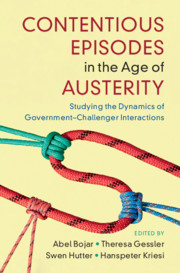 Contentious Episodes in the Age of Austerity
Contentious Episodes in the Age of Austerity A New Approach for Studying Political Contention – Contentious Episode Analysis
from Part I - A New Approach to the Analysis of Contentious Episodes
Published online by Cambridge University Press: 05 November 2021
On 24 May 2011, in the middle of the parliamentary debate on the so-called mid-term adjustment plan, yet another round of austerity imposed by Greece’s international creditors, a call for a demonstration at Syntagma Square in Athens and at the White Tower in Thessaloniki appeared on Facebook. By the next day at least 20,000 people assembled in the two squares, mostly chanting “thieves, thieves” at parliamentarians and cursing the Parliament. The movement of the Greek Indignados or Aganaktismenoi was born. It would prove to be massive, expansive, and innovative. Immediately after the initial demonstrations, the main squares in the two cities were occupied, and simultaneous protests began in almost all major urban centers of the country. Interest would focus on Syntagma Square, however, where the occupation was symbolically confronting Parliament, juxtaposing the public assembly and the symbolic seat of political power. In the following days, the occupation grew exponentially, eventually reaching almost 400,000 participants on June 5th. In our dataset, there is an event associated with the Aganaktismenoi on almost every single day until the end of the episode on June 30th.
To save this book to your Kindle, first ensure [email protected] is added to your Approved Personal Document E-mail List under your Personal Document Settings on the Manage Your Content and Devices page of your Amazon account. Then enter the ‘name’ part of your Kindle email address below. Find out more about saving to your Kindle.
Note you can select to save to either the @free.kindle.com or @kindle.com variations. ‘@free.kindle.com’ emails are free but can only be saved to your device when it is connected to wi-fi. ‘@kindle.com’ emails can be delivered even when you are not connected to wi-fi, but note that service fees apply.
Find out more about the Kindle Personal Document Service.
To save content items to your account, please confirm that you agree to abide by our usage policies. If this is the first time you use this feature, you will be asked to authorise Cambridge Core to connect with your account. Find out more about saving content to Dropbox.
To save content items to your account, please confirm that you agree to abide by our usage policies. If this is the first time you use this feature, you will be asked to authorise Cambridge Core to connect with your account. Find out more about saving content to Google Drive.